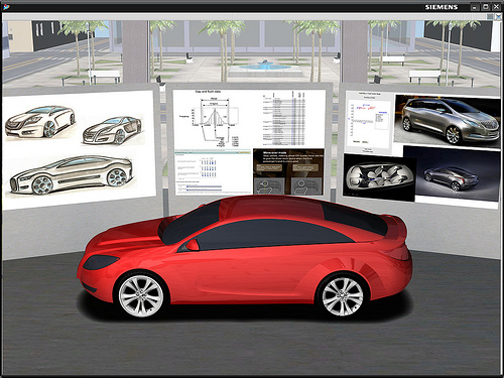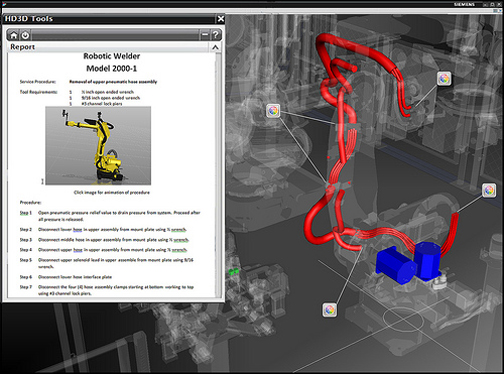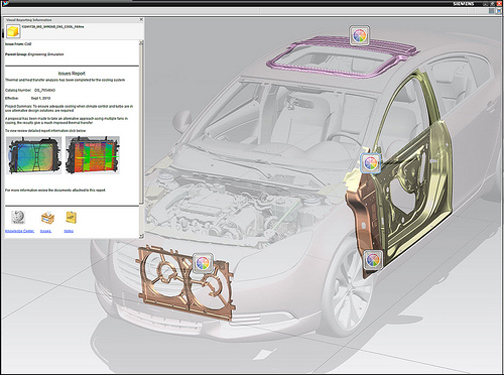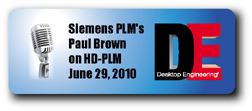Siemens PLM Connection 2010: NX Goes HD
Latest News
June 29, 2010



The news that broke today at Siemens PLM Connection 2010 in Dallas, Texas, was initially meant to break in the Grand Ole Opry in Nashville, Tennessee, in May—a full month earlier. But two weeks before the scheduled event, the Cumberland River unleashed a flood. With the site of the event several feet under water, organizers had no choice but to relocate the conference. Consequently, the news Siemens PLM Software had originally planned to unleash almost simultaneously in China and the U.S.—first on May 20 at The World Expo in Shanghai, then on May 24 in America’s Country Music capital—was released a month apart.
But you can’t accuse the flood of stealing Siemens’ thunder. Even long before the flood, the company had foretold what was to come. Siemens’ HD3D, unveiled more than six months ago, was a precursor to the arrival of HD-PLM, or high-def product lifecycle management. (For more, read my previous blog post “NX7 with HD3D,” published November 2009.)
According to the announcement, “ HD3D unites the powers of NX and Teamcenter under the HD-PLM technology framework to visually and intuitively deliver the information necessary to understand, collaborate, and make decisions in a globally distributed product development environment.”
With HD-PLM, the functions that used to reside in two separate windows—3D models in NX, product lifecycle data in Teamcenter—can be displayed in a single, unified application window, inside NX7. Want to see change orders that are overdue? Want to see all the electronic components supplied by overseas contractors? Want to see all sub-assemblies with unresolved compliance issues? No need to log into a separate PLM window. Your NX7 assembly model is your window to the data housed in Teamcenter.
Dr. Helmuth Ludwig, president of Siemens PLM Software, observed, “Problems that are small are hard to find, but very easy to fix; problems that are big are easily found, but very hard to fix. The challenge is to find the problem when it’s still small, to spot it when you can easily solve it.”
Does overlaying enterprise data and lifecycle data (statistics, deadlines, inventories, supplier locations, and so on) on 3D geometry (say, the assembly model of a new Ford model) make smaller problems easier to identify? That depends on the complexity of your project.
But looking at lifecycle data on a 3D model does give you new insights you might not otherwise get from staring at columns of part numbers, expense reports, spreadsheets, and pie charts. You might, for example, discover that a single door handle has been holding you back from meeting your deadline.
The difference between seeing the culprit door handle as a part number buried beneath rows of data (which is traditionally how PLM systems display data) and seeing it as a highlighted spot on your model (which is how it would come up in HD-PLM) is the same as looking for a landmark hidden in a series of latitudes and longitudes in a database and locating the same landmark in Google Earth’s fully rendered 3D terrain.
Siemens’ U.S. rival Autodesk has adopted a similar approach to product data management (PDM) with the latest release of Autodesk Vault. (See “Data Management Has a New Face,” April 12, 2010.) Dassault Systemes, Siemens’ continental rival from Paris, France, also advocates a visual PLM navigation system, dubbed 3D Live.
More than once, I’ve heard industry insiders repeat the following punchline: PLM’s biggest competition, they revealed (often with a chuckle), is Excel. That’s not too far from the truth. Many small and mid-size businesses will admit to owning and operating homegrown PLM and PDM systems that are little more than customized Excel worksheets. If you examine a number of randomly selected commercial PLM and PDM interfaces, beneath the menu bars and drop-down windows, you’ll find a series of columns, grids, and cells—the building blocks of Excel.
Deep in the heart of Texas, where the prairie sky is wide and high, where everything from belt buckles to prime-cut beef beg to be big, the narrow confines of spreadsheet-style PLM interfaces are difficult to miss once you’ve seen Siemens’ HD-PLM and its rivals’ visual data-management efforts.
For more on Siemens’ HD-PLM, listen to my recorded interview with Paul Brown, Siemens’ senior marketing director of NX.

For photos from the conference, watch the slide show below. (To activate captions, place your cursor on the image and select the “i” icon.)
Subscribe to our FREE magazine, FREE email newsletters or both!
Latest News
About the Author
Kenneth Wong is Digital Engineering’s resident blogger and senior editor. Email him at [email protected] or share your thoughts on this article at digitaleng.news/facebook.
Follow DE





